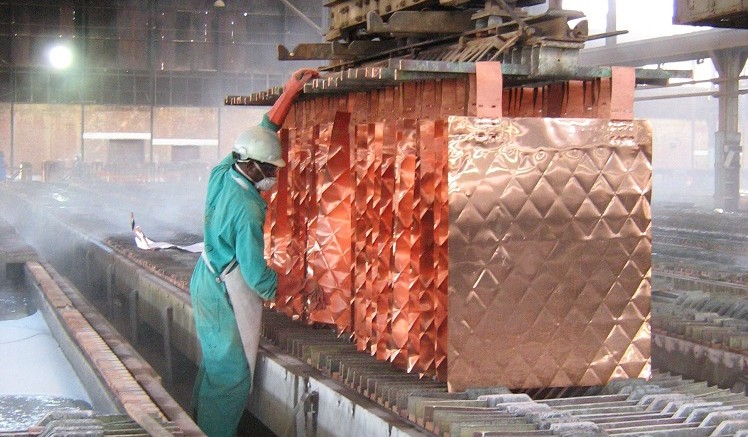After a two-year regulatory battle, J.P. Morgan Chase (JPM-N) has won approval from the U.S. Securities and Exchange Commission (SEC) to launch an investment vehicle that tracks the price of copper.
The product will be the first of its kind in North America, and was granted SEC approval despite strong opposition from North American copper users, who say inviting speculation into the copper market will artificially inflate prices.
The investment vehicle would be an exchange-traded fund (ETF) backed by an inventory of physical copper. ETFs are securities that track something else: an index such as the S&P 500, a commodity like copper or a basket of assets like an index fund. ETFs are made up of shares that trade on the market just like any other stock, so investors can speculate on the index or commodity behind the ETF by buying or selling shares of the fund.
This kind of speculation has copper users in North America worried. A group of such companies representing half of U.S. copper fabrication capacity argue the product would result in a “substantial artificially induced rise in near-term copper prices,” which would “wreak havoc” on the global economy.
The group found support in Carl Levin, chairman of the U.S. Senate subcommittee on investigations, who said the SEC’s approval of the copper ETF was “a blow to American businesses and consumers.” He believes the funds would “allow speculators to create a squeeze on the market” and “increase copper prices and volatility, and undermine market efforts to produce prices in response to supply and demand.”
The SEC sees it differently. In approving J.P. Morgan’s application to launch its copper ETF — a similar product from BlackRock iShares could follow — the SEC says it does not think copper-backed ETFs would impact prices, because they would not disrupt the supply of copper available for immediate delivery.
Indeed, a copper ETF would hold the metal, not consume it. If the price of copper climbs, the copper stockpile would increase in value. Since the fund’s shares represent a stake in the copper inventory, its share price would rise — and fall — with the price of copper.
J.P. Morgan suggests that its fund would hold a maximum of 61,800 tonnes copper cathode, equivalent to 27% of the copper held in London Metal Exchange warehouses. BlackRock’s ETF could hold as much as 121,200 tonnes, or almost half of the LME’s stocks. From another perspective, fabricators say these joint ETF holdings of 183,000 tonnes would represent most of the copper available in the U.S. through exchange-bonded warehouses.
These are maximum numbers. In all likelihood, the funds would start by amassing much smaller holdings. For example, J.P. Morgan says it plans to start trading with just 10,185 tonnes. Furthermore, even if the ETFs maxed out their holdings, the inventories would still be small relative to global annual production, which averages 20 million tonnes.
But limiting the physical availability of copper in North America is just one way these ETFs could impact copper prices. Another is through pure market speculation — investors could bid up the price of copper by bidding up the ETF’s share price.
The magnitude of this impact would only be known once the funds are established. In Europe, two ETFs backed by physical copper have been launched in the past 18 months, and both have had limited success. Bankers generally believe the products could be more successful in the U.S., where large-asset managers have fewer commodity investments available.
Some bankers disagree. Société Générale notes metal inventories incur high storage and insurance costs, which mean these copper-backed ETFs would have to gain 4% to 5% annually just to break even. But the goal isn’t to break even — it’s to beat the returns offered by investments with similar risk. If stock XYZ provides a basic 2% dividend return, a copper ETF would have to gain 6%, or 7%, to compete.
Facts aside, investors may well be interested in trying a copper ETF on for size after 10 years of highly successful gold ETFs.
In the early 2000s, the only way for the average day trader to ride the rising price of gold was to buy gold-mining stocks, just as the only way for investors today to play the price of copper is to buy copper miners. Then in late 2004 the SPDR Gold Trust ETF debuted, allowing investors to play the price of gold directly. The gold ETF also offered an entry into the gold market unburdened by the operating, political and hedging risks inherent in most mining stocks.
Investors flocked to the lower-risk gold ETF. Gold miners, which until then had loosely tracked the price of gold, were left in the dust.
If these new ETFs drive the price of copper higher, copper miners would profit in the long run. But if investors flock to the seemingly greener pastures of copper ETFs, share prices for copper explorers, developers and miners would lose.
At this early stage, how that balance will play out is anyone’s guess. But the SEC’s green light to J.P. Morgan answers one of the questions swirling around these copper ETFs — whether they will happen — but many more remain.


Be the first to comment on "SEC approves first copper-backed ETF"